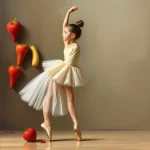Vegetarian and Vegan Diets for Ballet Dancers: Ensuring Adequate Nutrition

Introduction
Ballet dancers are renowned for their grace, strength, and endurance. To maintain peak performance, they require a diet that supports their intense physical demands. Vegetarian and vegan diets have gained popularity for their health benefits and ethical considerations. However, ensuring adequate nutrition on these diets can be challenging, especially for athletes like ballet dancers who have specific nutritional needs. This article explores how ballet dancers can thrive on vegetarian and vegan diets by focusing on essential nutrients, meal planning, and practical tips.
Understanding the Nutritional Needs of Ballet Dancers
Energy Requirements
Ballet dancers expend a significant amount of energy during rehearsals, performances, and training sessions. Therefore, they need a diet that provides sufficient calories to fuel their activities. A calorie deficit can lead to fatigue, decreased performance, and increased risk of injury.
Macronutrients
Macronutrients—carbohydrates, proteins, and fats—are the building blocks of a dancer’s diet.
- Carbohydrates: Carbs are the primary energy source for high-intensity activities. Whole grains, fruits, vegetables, and legumes are excellent sources of complex carbohydrates.
- Proteins: Proteins are essential for muscle repair and growth. Plant-based protein sources include beans, lentils, tofu, tempeh, and quinoa.
- Fats: Healthy fats are crucial for hormone production and overall health. Nuts, seeds, avocados, and olive oil are good sources of unsaturated fats.
Micronutrients
Micronutrients, including vitamins and minerals, play vital roles in various bodily functions. Ballet dancers need to pay special attention to the following:
- Iron: Essential for oxygen transport in the blood. Plant-based sources include lentils, chickpeas, spinach, and fortified cereals.
- Calcium: Important for bone health. Sources include fortified plant milks, tofu, almonds, and leafy greens.
- Vitamin B12: Crucial for nerve function and red blood cell production. Found in fortified foods and supplements.
- Vitamin D: Supports bone health and immune function. Obtained from sunlight exposure, fortified foods, and supplements.
- Omega-3 Fatty Acids: Important for heart and brain health. Sources include flaxseeds, chia seeds, walnuts, and algae-based supplements.
Meal Planning for Vegetarian and Vegan Ballet Dancers
Breakfast
A nutritious breakfast sets the tone for the day. Here are some ideas:
- Oatmeal: Top with fruits, nuts, and seeds for added nutrients.
- Smoothie Bowl: Blend fruits, spinach, plant-based protein powder, and top with granola and chia seeds.
- Tofu Scramble: Mix with vegetables and serve with whole-grain toast.
Lunch
Lunch should be balanced and provide sustained energy:
- Quinoa Salad: Combine quinoa, chickpeas, vegetables, and a tahini dressing.
- Lentil Soup: Pair with a side of whole-grain bread.
- Veggie Wrap: Fill a whole-grain wrap with hummus, avocado, and mixed vegetables.
Snacks
Healthy snacks can keep energy levels stable between meals:
- Fruit and Nut Mix: A combination of dried fruits and nuts.
- Vegetable Sticks with Hummus: Carrot, cucumber, and bell pepper sticks.
- Energy Balls: Made from dates, nuts, and seeds.
Dinner
Dinner should be nutrient-dense to aid recovery:
- Stir-Fry: Tofu or tempeh with mixed vegetables and brown rice.
- Stuffed Peppers: Filled with quinoa, black beans, and vegetables.
- Vegetable Curry: Serve with whole-grain naan or brown rice.
Hydration
Staying hydrated is crucial for performance and recovery. Ballet dancers should aim to drink water throughout the day and consider electrolyte-rich beverages during intense training sessions.
Supplements for Vegetarian and Vegan Ballet Dancers
While a well-planned vegetarian or vegan diet can meet most nutritional needs, some supplements may be necessary:
- Vitamin B12: Essential for vegans, as it is not naturally found in plant foods.
- Vitamin D: Especially important in regions with limited sunlight.
- Iron: Consider if blood tests indicate low levels.
- Omega-3 Fatty Acids: Algae-based supplements can provide DHA and EPA.
- Protein Powder: Plant-based protein powders can help meet protein needs, especially post-workout.
Practical Tips for Ballet Dancers on Vegetarian and Vegan Diets
Plan Ahead
Meal planning and preparation can help ensure a balanced diet. Batch cooking and having healthy snacks on hand can prevent reliance on less nutritious options.
Listen to Your Body
Pay attention to hunger cues and energy levels. Adjust portion sizes and meal frequency as needed to meet energy demands.
Consult a Nutritionist
A registered dietitian or nutritionist with experience in sports nutrition can provide personalized guidance and help address any nutritional gaps.
Stay Informed
Keep up-to-date with the latest research on vegetarian and vegan nutrition. New products and fortified foods are continually being developed to support plant-based diets.
FAQ
Can ballet dancers get enough protein on a vegetarian or vegan diet?
Yes, ballet dancers can get enough protein from plant-based sources such as beans, lentils, tofu, tempeh, quinoa, nuts, and seeds. Including a variety of these foods throughout the day can help meet protein needs.
What are the best sources of iron for vegetarian and vegan ballet dancers?
Plant-based sources of iron include lentils, chickpeas, spinach, fortified cereals, tofu, and pumpkin seeds. Consuming vitamin C-rich foods (like citrus fruits, bell peppers, and tomatoes) alongside iron-rich foods can enhance iron absorption.
Do vegetarian and vegan ballet dancers need to take supplements?
Some supplements may be necessary, particularly for nutrients that are harder to obtain from a plant-based diet, such as vitamin B12, vitamin D, and omega-3 fatty acids. Consulting with a healthcare provider can help determine individual needs.
How can vegetarian and vegan ballet dancers ensure they get enough calcium?
Calcium can be obtained from fortified plant milks, tofu, almonds, sesame seeds, and leafy greens like kale and bok choy. Including a variety of these foods in the diet can help meet calcium needs.
What are some quick and easy snack ideas for vegetarian and vegan ballet dancers?
Healthy snack options include fruit and nut mixes, vegetable sticks with hummus, energy balls made from dates and nuts, whole-grain crackers with avocado, and smoothies with plant-based protein powder.
Conclusion
Vegetarian and vegan diets can support the demanding nutritional needs of ballet dancers when carefully planned. By focusing on a variety of nutrient-dense foods and considering supplements when necessary, dancers can maintain their energy levels, support muscle repair, and promote overall health. Meal planning, staying informed, and consulting with nutrition professionals can further enhance the success of a plant-based diet for ballet dancers. With the right approach, vegetarian and vegan ballet dancers can perform at their best while adhering to their dietary choices.





